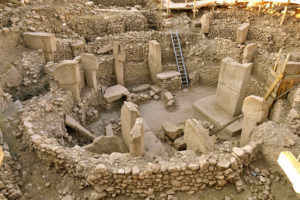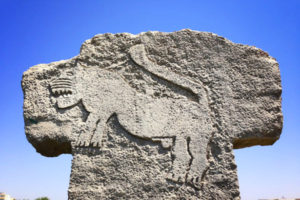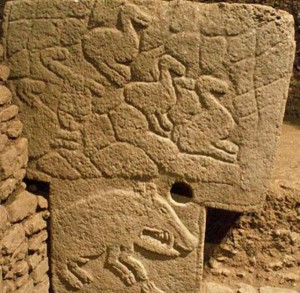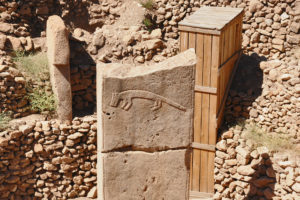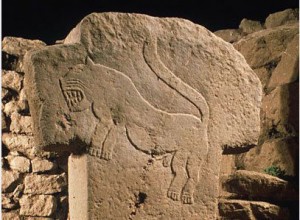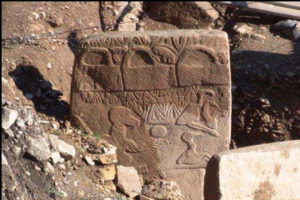(III) Gobeklitepe the first temple of the world (10.000 BCE)
Göbeklitepe is the oldest human-made site of worship yet discovered, dating back to the 10th – 8th millennium BCE. It is so old that predates the history of settled human life. It is pre-pottery, pre-writing, pre-everything.
Gobeklitepe temple complex predates (9,000 years before) the Pyramids of Giza and (6,000 years before) the Stonehenge. The site draws on questioning and rewriting the theory of human evolution.The astonishing discoveries at Gobeklitepe have long been a talking among academics.
Stratification layers suggests several millennia of activity, perhaps reaching back to the Mesolithic. Geophysical surveys indicate the existence of 16 additional structures. The site, currently undergoing excavation by German and Turkish archaeologists, was erected by hunter-gatherers in the 10th millennium BC (ca. 11,500 years ago), before the advent of sedentism.
The site includes two phases of ritual use dating back to the 10th – 8th millennium BCE. During the first phase, pre-pottery Neolithic A (PPNA), circles of massive T-shaped stone pillars were erected. More than 200 pillars in about 20 circles are currently known through geophysical surveys. Each pillar has a height of up to 6 m (20 ft) and a weight of up to 20 tons. They are fitted into sockets that were hewn out of the bedrock. In the second phase, Pre-Pottery Neolithic B (PPNB), the erected pillars are smaller and stood in rectangular rooms with floors of polished lime. The site was abandoned after the PPNB-period. Younger structures date to classical times.
An archaeological discovery of greatest importance
Göbekli Tepe is regarded as an archaeological discovery of the greatest importance since it could profoundly change the understanding of a crucial stage in the development of human society. Ian Hodder of Stanford University said, “Göbekli Tepe changes everything”. It shows that the erection of monumental complexes was within the capacities of hunter-gatherers and not only of sedentary farming communities as had been previously assumed. As excavator Klaus Schmidt put it, “First came the temple, then the city.”
Not only its large dimensions, but the side-by-side existence of multiple pillar shrines makes the location unique. There are no comparable monumental complexes from its time. Nevalı Çori, a Neolithic settlement also excavated by the German Archaeological Institute and submerged by the Atatürk Dam since 1992, is 500 years younger. Its T-shaped pillars are considerably smaller, and its shrine was located inside a village. The roughly contemporary architecture at Jericho is devoid of artistic merit or large-scale sculpture, and Çatalhöyük, perhaps the most famous Anatolian Neolithic village, is 2,000 years later.
At present Göbekli Tepe raises more questions for archaeology and prehistory than it answers. It remains unknown how a force large enough to construct, augment, and maintain such a substantial complex was mobilized and compensated or fed in the conditions of pre-sedentary society. Scholars cannot interpret the pictograms, and do not know for certain what meaning the animal reliefs had for visitors to the site; the variety of fauna depicted, from lions and boars to birds and insects, makes any single explanation problematic. As there is little or no evidence of habitation, and the animals pictured are mainly predators, the stones may have been intended to stave off evils through some form of magic representation. Alternatively, they could have served as totems. The assumption that the site was strictly cultic in purpose and not inhabited has also been challenged by the suggestion that the structures served as large communal houses, “similar in some ways to the large plank houses of the Northwest Coast of North America with their impressive house posts and totem poles.” It is not known why every few decades the existing pillars were buried to be replaced by new stones as part of a smaller, concentric ring inside the older one. Human burial may or may not have occurred at the site. The reason the complex was carefully backfilled remains unexplained. Until more evidence is gathered, it is difficult to deduce anything certain about the originating culture or the site’s significance.
Biblical connection
Klaus Schmidt from the German Archaeological Institute, leading the excavations, downplays extravagant spiritual interpretations of Gobeklitepe. Such as the idea, made popular in the press, the site is the inspiration for the Biblical Garden of Eden. He also says that there is plenty of historical evidence to show that Gobeklitepe may be the Garden of Eden and that it was a sanctuary of profound significance in the Neolithic world. He considers it as a key site in understanding the transition from hunting and gathering to agriculture, and from tribal to regional religion.
Yet there is plenty of historical evidence to show that the writers of the Bible, when talking of Eden, were, indeed, describing this corner of South East Turkey. Sanliurfa, a nearby city, is the Old Testament city of Ur. Harran, a town down the road, is mentioned in Genesis twice. Even the topography of Gobekli Tepe seems to be ‘correct’. The Bible describes rivers descending from Paradise. Gobekli Tepe sits in the ‘fertile crescent’ between the rivers Tigris and Euphrates. The Bible also mentions mountains surrounding Eden. From the brow of Gobekli’s hills you can see the Taurus range.
Historians have long wondered if the Eden story is a folk memory, an allegory of the move from hunter-gathering to farming. Seen in this way, the Eden story describes how we moved from a life of relative leisure – literally picking fruit from the trees – to a harsher existence of ploughing and reaping. And where did this change take place? Biologists now think the move to agriculture began in South east Turkey. Einkorn wheat, a forerunner of the world’s cereal species, has been genetically linked to here. Similarly, it now seems that wild pigs were first domesticated in Cayonu, just 60 miles from Gobekli.
***
SITE: Gobeklitepe /Sanliurfa (Southeast of Turkey)
MUSEUM: Sanliurfa Museum

